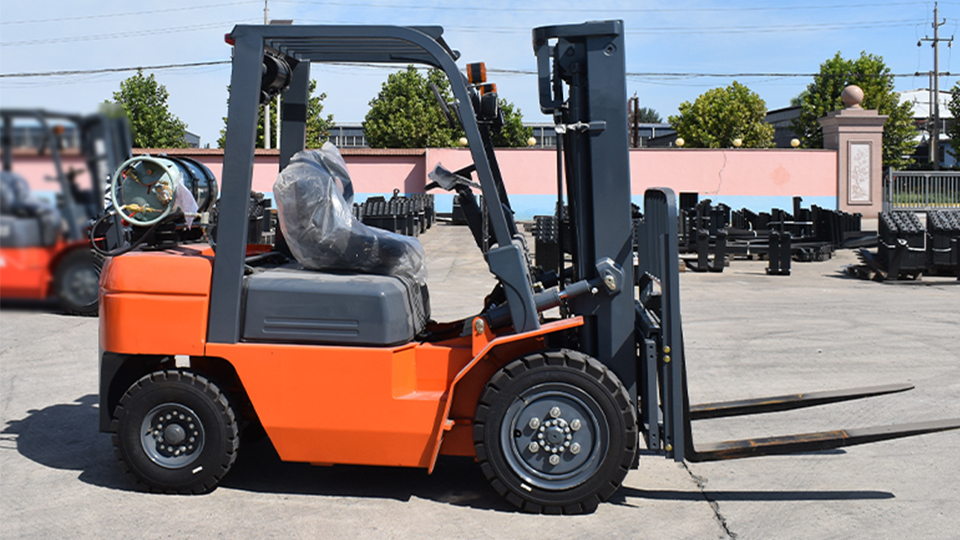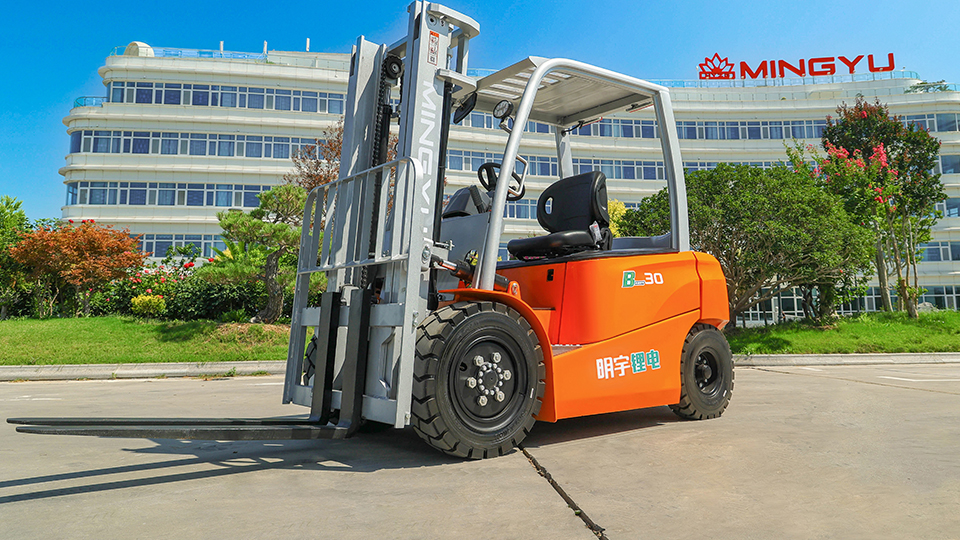
Introduction
The modern global economy is fundamentally reliant on the standardized shipping container. These ubiquitous, corrugated steel boxes are the backbone of intermodal transport, seamlessly traversing oceans, rails, and roads. Their handling and movement, particularly within ports, container yards, and industrial settings, is a critical operation, typically executed by specialized, heavy-duty machinery like reach stackers, straddle carriers, and colossal gantry cranes.
Given the sheer presence of forklifts—the workhorse of virtually every warehouse and logistics facility—a common, yet fundamentally important, technical question arises: Can a standard, or even a large, industrial forklift successfully move a fully-loaded or even an empty ISO shipping container? This 2000-word technical article will delve deep into the engineering, physics, and operational constraints that govern this scenario. We will analyze container specifications, various forklift classifications, the mechanics of load distribution, stability concerns (both static and dynamic), and the practical implications, concluding that while specialized, oversized forklifts can technically move empty containers, the task is almost universally impractical, hazardous, and impossible for the vast majority of commonly available forklifts, especially with a laden container.
I. Defining the Variables: Shipping Containers and Forklifts
To accurately assess the feasibility of this operation, we must first establish the technical specifications of both the load and the proposed moving equipment.

A. ISO Shipping Container Specifications (The Load)
The most common shipping containers adhere to the standards set by the International Organization for Standardization (ISO).
20-foot General Purpose (20' GP):
Tare Weight (Empty): Approximately 2,300 kg (5,100 lbs).
Max Gross Mass (Loaded): Up to 30,480 kg (67,200 lbs).
Dimensions: 6.06 m (20 ft) long, 2.44 m (8 ft) wide, 2.59 m (8 ft 6 in) high.
40-foot High Cube (40' HC):
Tare Weight (Empty): Approximately 3,750 kg (8,270 lbs).
Max Gross Mass (Loaded): Up to 32,500 kg (71,650 lbs).
Dimensions: 12.19 m (40 ft) long, 2.44 m (8 ft) wide, 2.89 m (9 ft 6 in) high.
The crucial takeaway is the minimum load: an empty 40-foot container weighs nearly 4 metric tons. The maximum load exceeds 30 metric tons.
B. Forklift Classifications (The Mover)
Forklifts are categorized by their power source and design (Classes 1-5). For moving a container, we must consider the upper end of the capacity spectrum.
Standard Industrial Forklifts (Classes I, IV, V - most common):
Capacity Range: 1,500 kg to 8,000 kg (3,300 lbs to 17,600 lbs).
Application: Warehousing, general manufacturing.
Feasibility: Immediately ruled out. Their maximum capacity barely equals the empty weight of the smallest container, and this capacity is only valid at a standard load center (usually 500 mm or 600 mm).
Heavy-Duty "Monster" Forklifts (Specialized):
Capacity Range: 10,000 kg to 40,000 kg (22,000 lbs to 88,000 lbs).
Application: Steel mills, lumber yards, machinery moving.
Feasibility: These are the only machines that possess the necessary rated capacity to theoretically lift an empty container, or a very lightly loaded 20-footer. Forklifts in the 30 ton+ range are often purpose-built for container handling and blur the line with dedicated equipment.
II. The Physics of the Lift: Load Center and Moment
The ability of a forklift to lift any object is governed by the principles of leverage and the stability triangle. The critical calculation is the Load Moment, which must not exceed the Counterbalance Moment provided by the machine's mass.
Load Moment=Load Weight×Load Center Distance
Counterbalance Moment=Forklift Weight×Counterbalance Center Distance
A. The Load Center Constraint
The Rated Capacity of a forklift is not a fixed number; it is inextricably linked to the Load Center Distance (D
LC
), which is the horizontal distance from the vertical face of the fork carriage to the load's center of gravity (CG). Standard ratings (e.g., 5,000 kg) assume a D
LC
of 500 mm or 600 mm.
A shipping container, however, presents an extreme case.

Fork Length Requirement: To safely engage a container, the forks must extend far enough to support the load and distribute the stress. While a container's undercarriage is reinforced, the load's CG will be significantly further out than the standard rating distance. To lift a container, the forks must engage the fork pockets (if present on a 20-footer) or simply slide underneath the entire 2.44 m width. Standard forks are typically 1.2 m to 1.8 m long. Specialized container handling equipment uses forks 2.5 m to 3.5 m long.
Impact on Capacity: Assuming a simplistic scenario where an empty 20 ft container (2,300 kg) is lifted using very long forks, its center of gravity (CG) would be located at 1.22 m from the mast.
This calculation shows that a 10 ton forklift is instantly de-rated to less than 5 tons due to the extended load center. While this 4,918 kg capacity could theoretically lift the 2,300 kg empty 20 ft container, it offers zero margin for error, dynamic forces, or uneven loading.
B. Stability Triangle and Tipping
A forklift's stability depends on keeping the combined CG of the machine and the load within the stability triangle defined by the two front wheel centers and the centerline of the rear steering axle pivot point.
When lifting a container, the CG shifts dramatically forward and upward.
Longitudinal Stability (Forward Tipping): This is the immediate, catastrophic risk. As the container is lifted and the load moment increases, the CG of the entire system moves toward the fulcrum (the front wheel axle). If the Load Moment exceeds the Counterbalance Moment, the rear wheels lift off the ground, resulting in a dangerous, uncontrolled forward tip. Even an empty container presents a massive wind load, which can add significant dynamic (transient) forward moment.
Lateral Stability (Sideways Tipping): Containers are long (6 m or 12 m) and relatively narrow (2.44 m). The machine's handling characteristics are completely altered. Turning with such a long, high load raises the combined CG, significantly decreasing the angle at which the machine will laterally tip over, even at slow speeds. The risk of the container's long axis creating a disastrous pendulum effect is extreme.
III. Operational and Structural Constraints
Beyond theoretical physics, several practical and structural factors render this operation highly problematic.
A. Structural Engagement and Stress
Standard containers are designed to be lifted by their top corner castings (by gantry cranes or spreaders) or their bottom corner castings (by chassis). They are not designed to be lifted solely by the fork pockets or by forks underneath the main structure, especially over their entire width, except for 20 ft units that are manufactured with dedicated fork pockets.
Fork Pockets: On many 20 ft containers, two reinforced slots, the fork pockets, are designed for occasional forklift movement when empty. These pockets are spaced only 2.05 m apart.
40-foot Containers: Crucially, 40 ft containers are generally not equipped with fork pockets. Attempting to lift a 40 ft unit by sliding forks underneath the middle will result in the structure's bottom rails buckling and the floor collapsing, as the middle section of the container is not load-rated for such localized, massive stress concentration. The maximum span allowed for this type of lift without permanent deformation is typically around 6 m, half the length of a 40 ft unit.
B. Visibility and Maneuverability
A standard mast forklift, even a large one, has a cab positioned low to the ground. Placing a 2.59 m to 2.89 m tall container on the forks completely obstructs the operator's forward and upward line of sight, creating an insurmountable safety hazard for navigation. Furthermore, the 6 m or 12 m length of the container will extend far past the machine's wheelbase, making even a slight turn a wide-sweeping, dangerous maneuver that could strike nearby objects or personnel.
C. Legal and Safety Compliance
Any material handling operation must adhere to strict safety standards (e.g., OSHA, ISO 3691). Using a machine outside its rated capacity, or using a non-approved attachment to lift a container, is a direct violation of these standards. It invalidates insurance, creates significant liability, and puts the operator and surrounding environment at extreme risk. Reputable organizations prohibit using equipment for tasks beyond its designed and certified operational scope.
IV. Dedicated Container Handling Equipment: The Proper Tools
The fact that the global shipping industry requires specialized machinery underscores the inherent difficulty and danger of using a general-purpose forklift.
Reach Stackers: These are the most common landside container movers. They use a telescopic boom and a top-lifting spreader (that locks into the corner castings) to lift, stack, and move containers up to five high. Their capacity often exceeds 45 tons, and their design accounts for the massive cantilevered load.
Container Handlers (Empty/Laden): These are essentially specialized, heavy-duty forklifts with a high-mounted cab and a specialized spreader attachment, designed with the necessary counterweight, stability, and lifting height.
Straddle Carriers and Gantry Cranes: Used for high-volume, high-density stacking.
These machines are engineered with massive ballast, wide wheelbases, and elevated operator positions specifically to manage the extreme load center and dynamic forces associated with container movement.
Conclusion
Can a forklift move a shipping container?
A fully-loaded container (20' or 40'): No. It is a physical impossibility for any standard industrial forklift. Even the largest heavy-duty forklifts (up to 40 tons) only barely meet the weight requirement, and when factoring in the required long load center, they fall short of the necessary capacity to maintain longitudinal stability. The forces involved would lead to immediate catastrophic failure via forward tipping or structural damage to the forklift components (mast, hydraulic cylinders, tires, and axles).
An empty 40-foot container: No. The lack of fork pockets and the structural weakness of the central span make lifting this container with forks extremely dangerous, risking buckling and floor collapse.
An empty 20-foot container with fork pockets: Yes, but only with a specialized, heavy-duty forklift (10 ton+ rated capacity) and only for short, level movements. The operation is technically possible under ideal conditions but remains inherently risky due to the extreme load center de-rating the forklift's capacity, poor operator visibility, and the lack of a sufficient safety margin for dynamic effects.
In summary, the use of a standard forklift for any container movement is a clear violation of safety protocols and engineering limitations. The cost of a specialized container handler is a necessary investment to ensure the safe, efficient, and structurally sound handling of the backbone of global commerce. The specialized nature of container transport demands specialized equipment designed to manage the unique constraints of this massive, leverage-intensive load.
Name: selena
Mobile:+86-13176910558
Tel:+86-0535-2090977
Whatsapp:8613181602336
Email:vip@mingyuforklift.com
Add:Xiaqiu Town, Laizhou, Yantai City, Shandong Province, China